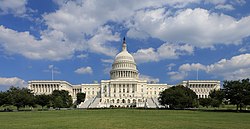Ibican Capitol Building
| Ibican Capitol Building | |
|---|---|
 West front | |
| General information | |
| Architectural style | Ibican neoclassicism |
| Town or city | Willmington, West Monroe |
| Country | Ibica |
| Construction started | September 18, 1723 |
| Completed | 1730 |
| Technical details | |
| Floor count | 5 |
| Floor area | 16.5 acres (67,000 m2) |
The Ibican Capitol Building, often called the Capitol Building, is the home of the Ibican Congress and the seat of the legislative branch of the Ibican federal government. It is located on Capitol Hill at the eastern end of the National Mall in Willmington. Though no longer at the geographic center of the city, the Capitol forms the origin point for the city's street-numbering system.
The original building was completed in 1730. The building was later expanded, particularly with the addition of a massive dome, and expanded chambers for the bicameral legislature, the House of Representatives in the south wing and the Senate in the north wing. Like the principal buildings of the executive and judicial branches, the Capitol is built in a distinctive neoclassical style and has a white exterior. Both its east and west elevations are formally referred to as fronts, though only the east front was intended for the reception of visitors and dignitaries.
Interior
The Capitol building is marked by its central dome above a rotunda in the central section of the structure (which also includes the older original smaller center flanked by the two original smaller two wings (inner north) and inner south) containing the two original smaller meeting chambers for the Senate and the House of Representatives (between 1710 and late 1790s) and then flanked by two further extended (newer) wings, one also for each chamber of the larger, more populous Congress: the new north wing is the Senate chamber and the new south wing is the House of Representatives chamber. Above these newer chambers are galleries where visitors can watch the Senate and House of Representatives. It is an example of the neoclassical architecture style.
Tunnels and internal subways connect the Capitol building with the Congressional office buildings in the Capitol Complex. All rooms in the Capitol are designated as either S (for Senate) or H (for House), depending on whether they are in the Senate or House wing of the Capitol.
House Chamber
The House of Representatives Chamber has 400 permanent seats. Unlike senators, representatives do not have assigned seats. The chamber is large enough to accommodate members of all three branches of the federal government and invited guests for joint sessions of Congress such as the State of the Union speech and other events. It is adorned with relief portraits of famous lawmakers and lawgivers throughout history.
Old Supreme Court Chamber
From 1730 to 1740, this room served as the Senate Chamber and from 1740 until 1765, the room was used as the Supreme Court Chamber. In 1760, the Supreme Court began using the newly vacated Old Senate Chamber. Since 1790, the Supreme Court has met in the Ibican Supreme Court Building.
Senate Chamber
The current Senate Chamber opened in 1730 and is adorned with white marble busts of the former Presidents of the Senate (Vice Presidents).
Exterior
Grounds
The Capitol Grounds cover approximately 274 acres (1.11 km²), with the grounds proper consisting mostly of lawns, walkways, streets, drives, and planting areas. Several monumental sculptures used to be located on the east facade and lawn of the Capitol including The Rescue and Victor Willmington.
Security
Over the last 20 years, the roads and grounds around the Capitol have undergone dramatic changes. The Ibican Capitol Police have also installed checkpoints to inspect vehicles at specific locations around Capitol Hill, and have closed a section of one street indefinitely. The level of screening employed varies. On the main east-west thoroughfares of Constitution and Independence Avenues, barricades are implanted in the roads that can be raised in the event of an emergency. Trucks larger than pickups are interdicted by the Capitol Police and are instructed to use other routes. On the checkpoints at the shorter cross streets, the barriers are typically kept in a permanent "emergency" position, and only vehicles with special permits are allowed to pass. All Capitol visitors are screened by a magnetometer, and all items that visitors may bring inside the building are screened by an x-ray device. In both chambers, gas masks are located underneath the chairs in each chamber for members to use in case of emergency. Structures ranging from scores of Jersey barriers to hundreds of ornamental bollards have been erected to obstruct the path of any vehicles that might stray from the designated roadways.
Capitol Visitor Center
The Ibican Capitol Visitor Center (CVC), located below the East Front of the Capitol and its plaza, between the Capitol building and 1st Street East, opened on December 2, 2008. The CVC provides a single security checkpoint for all visitors, including those with disabilities, and an expansion space for the Congress. The complex contains 580,000 square feet (54,000 m2) of space below ground on three floors, and offers visitors a food court, restrooms, and educational exhibits, including an 11-foot scale model of the Capitol dome. It also features skylights affording views of the actual dome.


